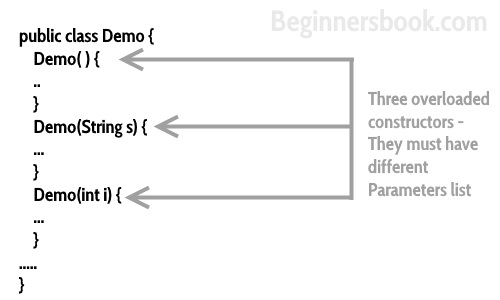Providing Constructors for Your Classes (The Java™ Tutorials > Learning the Java Language > Classes and Objects) https://docs.oracle.com/javase/tutorial/java/javaOO/constructors.html
A class contains constructors that are invoked to create objects from the class blueprint. Constructor declarations look like method declarations—except that they use the name of the class and have no return type. For example, Bicycle has one constructor:
Constructor Overloading in Java with examples https://beginnersbook.com/2013/05/constructor-overloading/

Constructor overloading is a concept of having more than one constructor with different parameters list, in such a way so that each constructor performs a different task. For e.g. Vectorclass has 4 types of constructors. If you do not want to specify the initial capacity and capacity increment then you can simply use default constructor of Vector class like this Vector v = new Vector(); however if you need to specify the capacity and increment then you call the parameterized constructor of Vector class with two int arguments like this: Vector v= new Vector(10, 5);
You must have understood the purpose of constructor overloading. Lets see how to overload a constructor with the help of following java program.
Constructor Overloading Example
Here we are creating two objects of class StudentData. One is with default constructor and another one using parameterized constructor. Both the constructors have different initialization code, similarly you can create any number of constructors with different-2 initialization codes for different-2 purposes.
StudentData.java
class StudentData
{
private int stuID;
private String stuName;
private int stuAge;
StudentData()
{
//Default constructor
stuID = 100;
stuName = "New Student";
stuAge = 18;
}
StudentData(int num1, String str, int num2)
{
//Parameterized constructor
stuID = num1;
stuName = str;
stuAge = num2;
}
//Getter and setter methods
public int getStuID() {
return stuID;
}
public void setStuID(int stuID) {
this.stuID = stuID;
}
public String getStuName() {
return stuName;
}
public void setStuName(String stuName) {
this.stuName = stuName;
}
public int getStuAge() {
return stuAge;
}
public void setStuAge(int stuAge) {
this.stuAge = stuAge;
}
public static void main(String args[])
{
//This object creation would call the default constructor
StudentData myobj = new StudentData();
System.out.println("Student Name is: "+myobj.getStuName());
System.out.println("Student Age is: "+myobj.getStuAge());
System.out.println("Student ID is: "+myobj.getStuID());